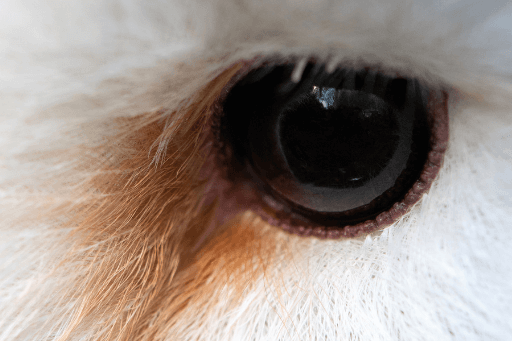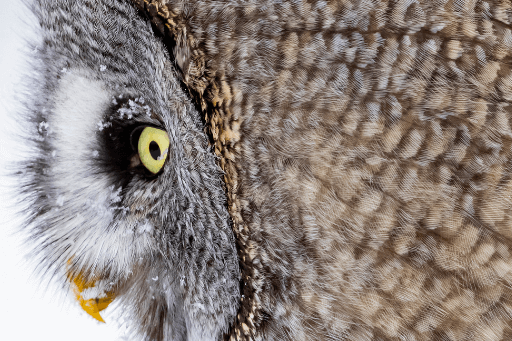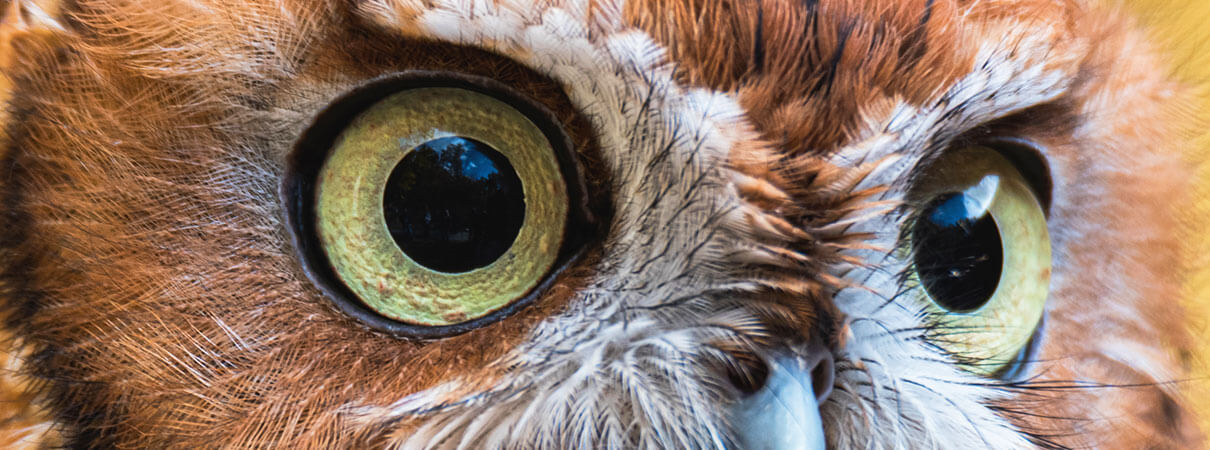“Owl” Be Seeing You: Amazing Facts About Owl Eyes
The bird world is full of majestic hunters like eagles, hawks, and falcons, but when the sun sets, one group of avian predators reigns supreme.
Owls have many adaptations that make them excellent at stalking prey at night, including specialized wing feathers for silent flight, asymmetrical ears for triangulating the locations of sounds made by their prey, and legs tipped with deadly talons. Overall, though, there's one characteristic in particular that birdwatchers find captivating: owls' eyes.
Below, we've rounded up details on all the features that make owl eyes so amazing. We hope you'll find them just as astounding and “eye-opening” as we do!

The Perfect Predator
Owls' distinctive “wise” appearance comes from the intense stare resulting from the position of their piercing eyes, both of which are located facing forward on the front of the head, like our own. This arrangement is actually an adaptation for tracking the movements of potential prey.
Where their two eyes' fields of view overlap, owls have 3-D or “binocular” vision, a trait they share with humans and the many other predatory animals. This provides them with acute depth perception that allows them to gauge distance to perfectly time their attacks. In fact, owls have the most forward-facing eyes of any group of birds!
Prey animals, on the other hand, tend to have eyes situated on the sides of their heads. This arrangement sacrifices depth perception for a wider field of view that gives them a better chance of spotting incoming danger.
Although humans and owls share binocular vision, owls are equipped with an important feature that we lack: nictitating membranes. These translucent “third eyelids” close horizontally from the inside corner of owl eyes and are there to protect them from debris when the owl swoops in for the attack.

Night Vision
Forward-facing eyes and extra eyelids aren't the only optical advantages that owls possess. They have one important habit that sets them apart from other avian predators: Most of them hunt at night. And that means they need to be really, really good at seeing in the dark.
Owls' enormous eyes help them take in enough light to see, even after the sun sets. Owl eyes make up as much as 5 percent of these birds' total body weight. That may not sound like a lot, but for comparison, your eyeballs are about 0.0003 percent of your total weight.

In addition to their out-sized eyes, owl pupils dilate extremely wide to let as much light as possible hit the light-sensitive retina at the back of the eye.
Like us, owls have two different types of light-sensitive cells in their retinas — rods (which detect light and movement) and cones (which distinguish color). Humans have about 20 rods for every cone, but in owls that ratio is more like 30 to one, making them exceptionally good at picking up movement even when it's dark.
If you've ever been out at night and seen owl eyes shining back from your flashlight beam, you no doubt noticed their reflective power, which is yet another way that owls enhance their night vision.
Behind an owl eye's rod-packed retina is another layer called the tapetum lucidum, which catches any light that may have passed through the retina and bounces it back to those sensitive rods. All of these adaptations add up: Some owl eyes may be as much as 100 times more sensitive in low light than ours. The one downside is that owls tend to be farsighted and experience difficulty focusing on objects at close range, but sensitive bristles around their beaks make up for this a bit, giving them another way to sense objects close to their faces.
“What Big Eyes You Have…”
There's just one problem: fitting those gigantic eyes into the relatively small skull of a bird.
Owls' eyeballs aren't really balls at all. They're more elongated than human eyes — yet another special adaptation to help them work more efficiently in low light. Owls have special bony structures called sclerotic rings to support these huge eye structures and hold them in place. These rigid rings prevent owls from being able to move their eyes — you can roll your eyes to the left or right while holding your head still, but an owl's eyes are fixed in place, pointing straight ahead.

To compensate, owls have evolved their famous ability to turn their necks incredibly far in either direction. They can't literally turn their heads all the way around, but they can rotate them 270 degrees (three quarters of a full circle) in either direction, plus 90 degrees up and down.
Owl eyes are so big that in some species, you can actually see the base of their eyes by peeking into their ears (check out this article from 2018 for some amazing photos). Of course, even owls can't see in total darkness, but some species, such as Barn Owls, can hunt by sound alone, able to catch mice even in a sealed, pitch-black environment.
But What About Daytime?
There is a common misconception that because owls have excellent night vision, that means they're blind in daylight. Not true! Owl pupils can contract in bright light just like ours do. They can dilate and contract the pupil of each eye independently, giving them an amazing amount of control over just how much light hits the retina in each eye.
In fact, some owl species are more active during the day than at night — and eye color can be a good indicator as to which type of owl you're seeing. Although there are many exceptions to this rule, a 2018 study found that, overall, nocturnal owls are more likely to have dark eyes (like the Barred Owl), while owls active in daytime or at dusk are more likely to have orange or yellow eyes (like the Snowy Owl).

Birds in Trouble
In less than a single human lifetime, 2.9 billion breeding adult birds have been lost from the United States and Canada, across every ecosystem. This includes familiar birds: The Dark-eyed Junco has lost an incredible 175 million individuals from its population. The White-throated Sparrow has lost 93 million.
Owls may be able to avoid detection during the day, but they cannot escape the same threats faced by other birds. Scientists have identified that habitat loss is the biggest overall driver of bird declines. Habitat loss occurs when land is converted for agriculture, development, resource extraction, and other uses. Habitat degradation is a second cause of losses. In this case, habitat doesn't disappear outright but becomes less able to support birds, such as when habitat is fragmented or altered by invasive plants, or when water quality is compromised.
Aside from habitat loss and degradation, other major human-caused threats to birds come from cats and other invasive species; collisions with glass and industrial infrastructure such as communications towers and wind turbines; and exposure to pesticides and other toxics.
Climate change is expected to exacerbate these threats, and also to create new challenges, for example, by changing habitat distributions and shifting the timing of peak food supplies for birds.

How You Can Help Owls
We all can do our part to protect owls and other birds.
American Bird Conservancy and our Joint Venture partners have improved conservation management on 6.4 million acres of U.S. bird habitat — an area larger than the state of Maryland — over the last ten years. This is a monumental undertaking, requiring the support of many, and you can help by making a gift today.
Policies enacted by Congress and federal agencies, such as the U.S. Fish and Wildlife Service, have a huge impact on America's birds. You can help shape these rules for the better by telling lawmakers to prioritize birds, bird habitat, and bird-friendly measures. To get started, visit ABC's Action Center.
Finally, don't overlook the impact you can have at home. Living a bird-friendly life can have an immediate impact on owls and the other birds around you. Doing so can be as easy as adding native plants to your garden, avoiding pesticides, and keeping cats indoors. To learn more, visit our Bird-Friendly Life page.
 | Rebecca Heisman is a science writer based in eastern Washington. Her first book, which tells the scientific backstory of how we know what we know about bird migration, will be out in spring 2022. |


















































